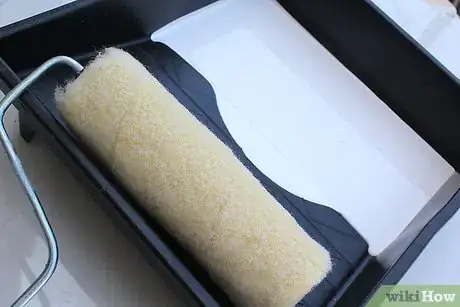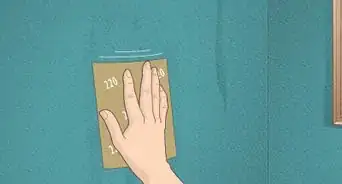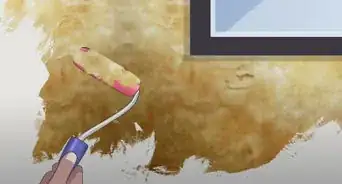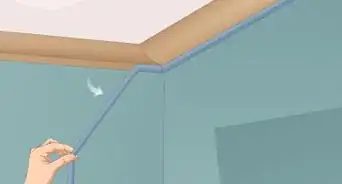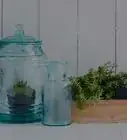wikiHow is a “wiki,” similar to Wikipedia, which means that many of our articles are co-written by multiple authors. To create this article, 9 people, some anonymous, worked to edit and improve it over time.
There are 7 references cited in this article, which can be found at the bottom of the page.
This article has been viewed 42,994 times.
Learn more...
Faux finishes that are textured with a rag (in place of a paint brush) add warmth and a sense of detail to a home or office space. This simple brush technique is a way to add an element of design to an interior while staying on a budget. Knowing how to rag paint a wall is a valuable skill for painters interested in transforming an interior space from something plain to a place with character. Follow these steps to learn how to rag paint a wall.
Steps
-
1Prepare the room where you will be painting by removing all furniture (if possible) and other obstacles. It's important in the process of knowing how to rag paint a wall to have a clear work area.[1]
-
2Cover the floor and any large furniture (like couches) that cannot be removed from the room with plastic drop cloths.[2]Advertisement
-
3Tape edges of the areas you do not wish to be painted to protect the areas from paint splatters and brush edges.[3]
-
4Pour paint for the base color into a paint tray. Use latex paint for the base color. This type of paint is easy to work with and to clean up and will provide a smooth base underneath the rag pattern.
- The base color latex paint is usually a lighter shade, so the glaze color that is rolled on top with the rag will stand out on top of the base coat.
-
5Mix the paint for the glaze that will be applied with a rag. To prepare, use a separate paint bucket and mix the latex paint with a glaze that is water-based. The glaze will give the wall a soft look and add a sheen.[4]
-
6Roll the base color latex paint on the walls, covering the walls completely. Allow to dry for 24 hours before adding the rag glaze.[5]
-
7Apply the glaze paint with a rag.[6]
- Moisten the rag slightly with water and then dip it into the glaze. Dab the rag onto the wall, making a pattern. Go back in with another rag to dab off excess paint to change the pattern. Experiment.
-
8Allow glaze paint to dry.
-
9Wash out rollers and brushes,[7] remove drop cloths, and return furniture to the newly rag-painted room.
Community Q&A
-
QuestionI am painting both the walls and the ceiling of a bedroom. How do I get a nice crisp paint edge between the two?
 Community AnswerPainter's tape. Pay for the more expensive variety; it's worth it.
Community AnswerPainter's tape. Pay for the more expensive variety; it's worth it. -
QuestionI want to rag roll a lighter green over a forest green wall. Will that work? I don't understand about glaze. Is that a separate step?
 TechdocgeekCommunity AnswerYes, it should work fine to put a lighter color over top a darker color. A glaze is a final transparent or semi-transparent layer to protect and make paints shine underneath it. Think of it like a fingernail gloss. In most cases it's a separate step. In this case, your second lighter green may be a glaze if it's thinner and lets the darker show through.
TechdocgeekCommunity AnswerYes, it should work fine to put a lighter color over top a darker color. A glaze is a final transparent or semi-transparent layer to protect and make paints shine underneath it. Think of it like a fingernail gloss. In most cases it's a separate step. In this case, your second lighter green may be a glaze if it's thinner and lets the darker show through.
Things You'll Need
- Drop cloths, plastic or canvas
- Bucket to mix the paint
- Paint sticks for stirring paint
- Masking tape to mask edges (low-tack)
- Latex paint for the base coat
- Latex paint in highlight color for rag painting
- Glaze (water-based)
- Cotton rags
References
- ↑ https://www.bhg.com/decorating/paint/room/how-to-prep-a-room-for-paint-281474979610966/
- ↑ https://www.thisoldhouse.com/painting/21017299/how-to-prep-a-room-for-paint
- ↑ https://www.realsimple.com/home-organizing/home-improvement/painting/six-steps-painting-room?slide=40710#40710
- ↑ https://www.thisoldhouse.com/painting/21015546/how-to-rag-roll-paint-for-an-old-world-look
- ↑ https://www.youtube.com/watch?v=PZ-XgnFsLNw
- ↑ https://www.youtube.com/watch?v=PZ-XgnFsLNw
- ↑ https://www.thisoldhouse.com/painting/21016922/how-to-clean-a-paint-roller
- http://www.ronhazelton.com/archives/howto/rag-roll_painting_techniques.shtm



